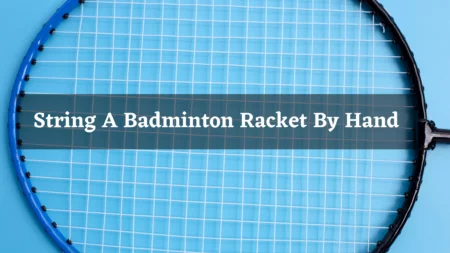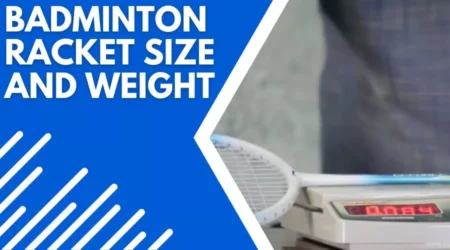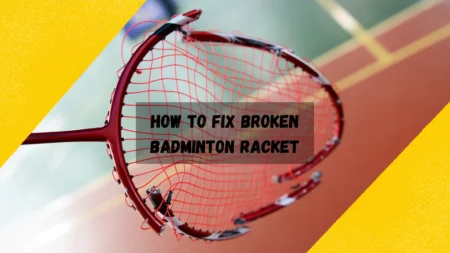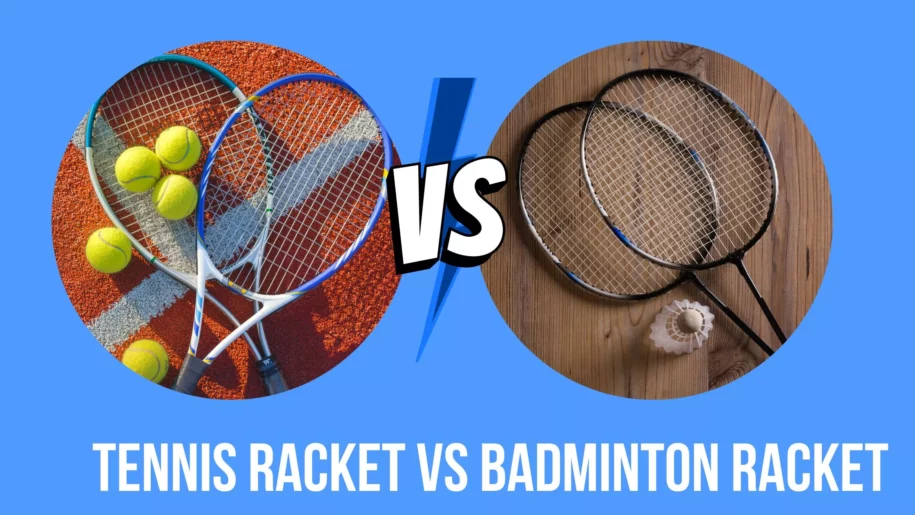
Badminton and tennis are two of the most popular racquet sports. Both badminton and tennis games require reflexes, stamina, and hand-eye coordination.
Because of their similarities, many people wonder what the difference between a badminton racket and a tennis racket is.
A badminton racket is longer than a tennis racket. This is to give players more reach when hitting the badminton shuttlecock so that it doesn’t land so close to them after being struck by the other player.
A badminton racket also has a smaller head; this makes it easier for players to make shots over their opponents’ heads.
Also, as with any sport involving a racquet and ball, both rackets have pros and cons based on your play style and preference.
Tennis Racket
Tennis rackets have a head size of 90-95 square inches. They have a more extended handle than badminton rackets (27-28 inches) and a smaller head (16-19 square inches).
The racquet strung weight is between 10-12 ounces. Because tennis rackets have smaller heads than badminton, tennis players can generate high racquet head speeds but can only hit the ball over a short distance.

This is because tennis rackets are designed for topspin, giving more control but less power than badminton.
Badminton players use a larger racket head to hit the shuttlecock farther, but tennis players hit the ball with topspin to make it land short of the baseline.
Tennis rackets are generally made of graphite or a combination of graphite and carbon fibres. Graphite is lighter than traditional wooden rackets and can be more expensive.
Badminton Racket
Badminton racket heads are more significant than tennis rackets (21-33 square inches). Badminton racket handles are shorter (22-27 inches) than tennis rackets, and the racket strung weight is heavier (11-17 ounces).

Badminton racket heads are larger to create more power, and the lighter racquet shaft more easily transfers energy to the shuttlecock when you hit it.
Badminton players hit the shuttlecock with a downward motion and need more head speed to hit the shuttlecock farther. Badminton rackets are designed for low-hitting action.
Types Of Tennis Rackets
There are many different tennis rackets, so choosing the right one for your game is essential.
Different tennis rackets are best suited for different playing styles, racquet styles, and skill levels.
Here are the different types of tennis rackets:
Types Of Badminton Rackets
While all badminton rackets are designed to hit a shuttlecock, different rackets have different features and technologies to help you achieve the best game. Badminton racket technology has advanced over the years, but there are three main types of badminton rackets that are made
What’s the Difference Between Badminton Racket and Tennis Racket
First, let’s discuss what the two racquet sports have in common. Per basic rules, tennis and badminton are racquet sports played with a racquet and ball on a badminton court or field.
Because of their popularity, it is no surprise that tennis and badminton racquets are widely available for purchase.
While the two sports are similar, they also have distinct differences. Badminton racquets are slightly longer than tennis racquets – the average length of a tennis racquet is 27 inches compared to a badminton racquet which is 28 inches long.
This is to give badminton players more reach to keep the shuttlecock away from their body, as well as make it easier to hit shots over the heads of their two opposing teams.
Both tennis and badminton rackets use tighter strings to create a significant and consistent sweet spot.
The strings are also relatively thin to enable tennis players to create a spin on the ball while keeping the racket lightweight.
The higher string tension in badminton rackets increases racquet head speed and creates more power than tennis rackets.
Badminton racket heads are more significant than tennis rackets. Badminton rackets generate more power than tennis rackets because of the larger head size, heavier weight, and higher string tension.
Differences In Length And Head Size
Badminton racquets are longer and have broader heads than tennis racquets. This is to give players more reach when hitting the shuttlecock so that it doesn’t land so close to them after being struck by the other player.
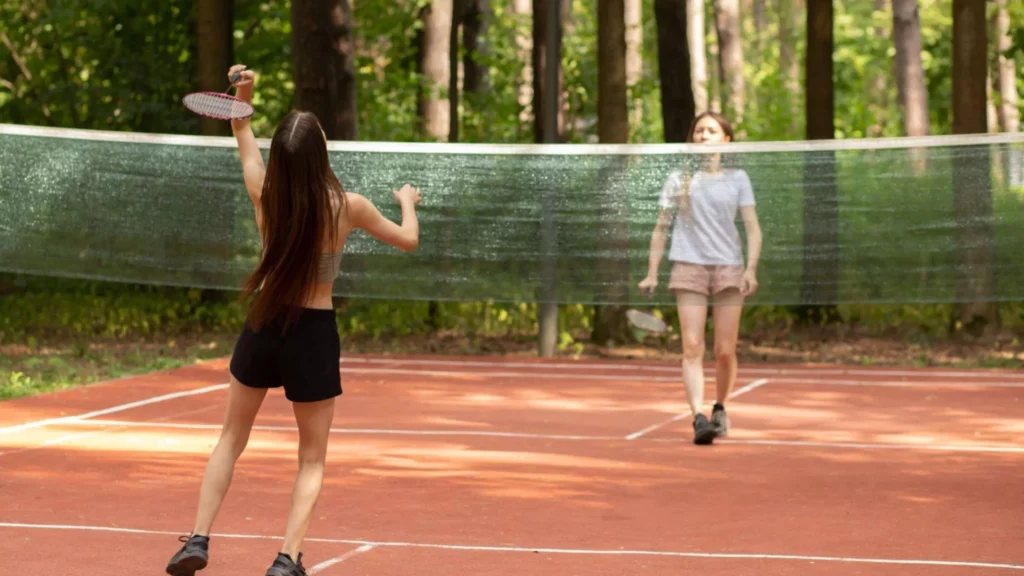
Badminton players also have to contend with a high-flying birdie that lands high above the net compared to a tennis ball that lands just above the net.
A badminton racket also has a smaller head; this makes it easier for players to make shots over their opponents’ heads.
The frame’s length, shape, and size can vary based on the player’s preference and skill set.
Differences In Stringing
Both tennis and badminton racquets are strung to have a large sweet spot. While the stringing pattern may differ slightly between the two rackets, they both have the same goal of making the tennis ball go where you want it to go.
The broader string pattern on a tennis racquet is usually made of synthetic materials, while badminton racquet strings are made of synthetic materials or natural materials (like gut).
As a rule, synthetic materials are more durable than natural materials, so tennis strings are usually synthetic, while badminton strings are generally unaffected.
Differences In Weight
The racquets in both sports are relatively lightweight. This is important because heavy rackets can cause wrist and arm strain.
Both rackets weigh between 300 and 350 grams, depending on the strings used.
A heavier racket will cause a more significant amount of force on the shuttlecock during play, which is why many players prefer to use a lighter racket.
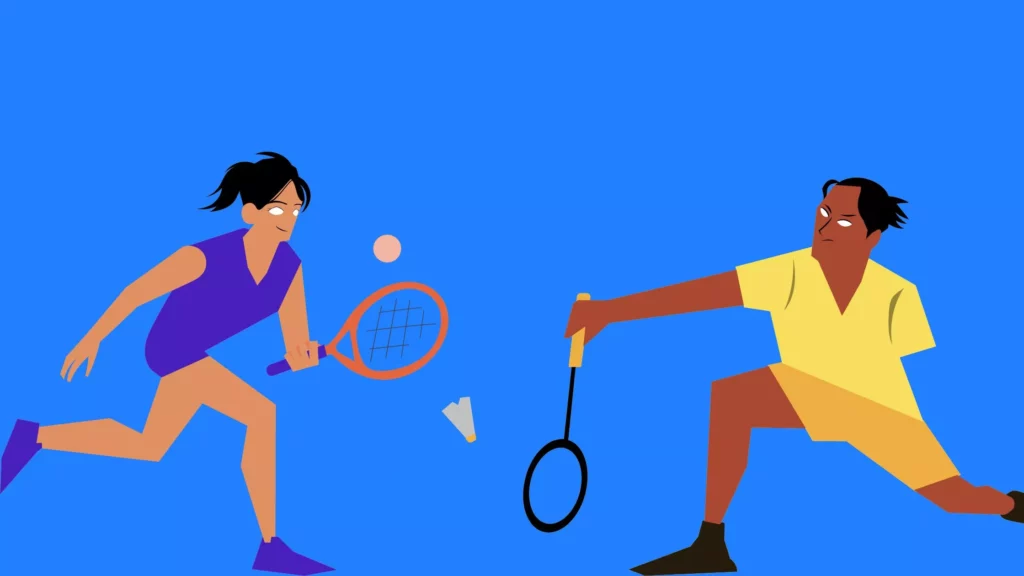
Badminton racquets are slightly heavier than tennis racquets. This is because tennis racquets are strung with synthetic strings, which are lighter than natural gut strings.
Differences In Grip Size And Shape
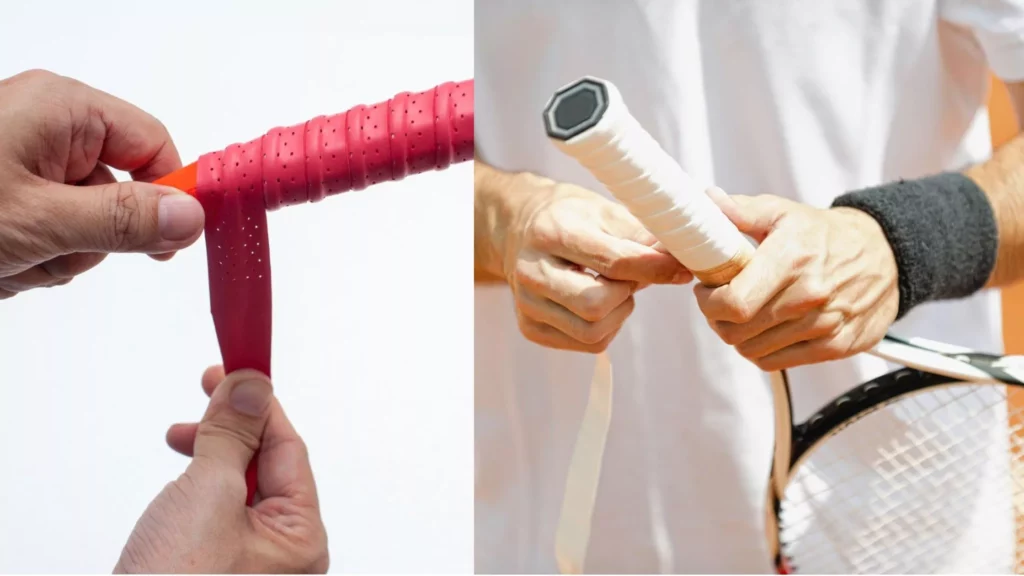
The grip size and shape are usually determined by the type of play you are engaged in. For example, the much thinner grip size and shape used in tennis differ from the kind used in badminton.
Tennis players will have a smaller grip size on their racquets, while badminton players will have a larger grip size. The shape of the racquets’ grips can also be different.
Tennis racquets have a rectangular-shaped grip, while badminton racquets have a triangular-shaped grip.
The different playing styles determine the different shapes in each sport. Tennis players need to have a wide range of motion, while badminton players need to be agile.
Conclusion
Badminton and tennis are racquet sports played with a racquet and ball on a court or field.
Both sports are popular and have many similarities, including the rackets used.
Badminton rackets are slightly longer than tennis racquets and have a larger head size.
Badminton rackets are also lighter than tennis rackets due to the type of strings used to string the racquet.
Tennis rackets are also strung with synthetic strings and are heavier than badminton racquets. These are just some of the key differences between a tennis racket and a badminton racket.
FAQS
Which Type of Racquet Is Best for You?
For a beginner, it is advisable to use a standard-sized badminton racket because the oversized head gives less control, and the flexible badminton racket is more expensive. Rackets are generally a one-size-fits-all, so it is best to try as many out to get a feel for what you like best. Badminton rackets vary in weight, length, string, and head size. A lighter racket is easier to swing but does not have as much power as a heavier racket.
Is a badminton racket bigger than a tennis racket?
No, the badminton racket is longer, and the tennis racket is wider. If you look at the rackets from the head down, you’ll see that the tennis racket is more comprehensive and the badminton racket is longer. Badminton rackets are generally longer because the shuttlecock needs to land further away so that the person hitting it can have more room to play. Tennis rackets are smaller because they are meant to be played with a very close net, and the shuttlecock needs to land very close to the person hitting it, so they have less room to play.
What makes a badminton racket different from a tennis racket?
In addition to the differences mentioned above, there are a few more points to note about badminton racquets: Badminton racquets are strung with natural gut strings, while tennis racquets are strung with synthetic strings. Badminton racquets are lighter than tennis racquets. – Badminton racquets have a more prominent sweet spot due to the use of natural gut strings. Badminton racquets are shorter than tennis racquets which makes them more agile.
What makes a tennis racket different from a badminton racket?
In addition to the differences mentioned above, there are a few more points to note about tennis racquets Tennis racquets are strung with synthetic strings, while badminton racquets are strung with natural gut strings. Tennis racquets are heavier than badminton racquets. Tennis racquets have a smaller sweet spot due to synthetic strings Tennis racquets are longer than badminton racquets, making them slower but more powerful.
What’s the same about a tennis racket and a badminton racket?
Both tennis and badminton racquets have the same purpose: the player strikes a ball or shuttlecock to create a point. Both rackets allow the ball or shuttlecock to travel faster while giving the player more power. Both rackets also have a grip to make holding the racket easy and comfortable.
Can you use a tennis racket for badminton?
While it is possible to use a tennis racket for badminton, it is not recommended. While the two sports are similar, there are also many differences between them. If you use a tennis racket for badminton, you may not have the power or control you need to play the game.


